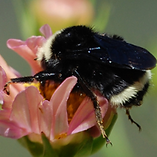I am an Ecological Data Scientist at the World Wildlife Fund, focused on grassland conservation in the North American Great Plains. I work closely with partner organizations, government agencies, and stakeholders to track conservation impacts and progress across 25 M+ ha in the Central and Eastern Montana plains. I also contribute to projects focusing on pollinator conservation and endangered species monitoring using environmental DNA (eDNA).
Prior to joining WWF I was a Research Ecologist with the U.S Forest Service, where my research focused on how logging and prescribed burning activities shape native pollinator communities, plant-animal interactions, and affect dispersal. In 2022, I completed a post-doc in Dr. Beth Shapiro's lab (Paleogenomics Lab) at the University of California Santa Cruz where I used

contemporary and ancient (aDNA) and eDNA to inform conservation of several threatened and endangered vertebrate and invertebrate species. I also developed and taught an undergraduate biology course using inclusive teaching practices, with eDNA as a framework for STEM education.
I completed my PhD in Ecology, Evolution, and Behavior at the University of Texas at Austin, supervised by Dr. Shalene Jha. My dissertation research focused on how urban landscapes shape native bee communities and genetic population structure, and I also developed best-practice methods for next-generation sequencing of field-collected bee specimens.
Ongoing Research
Wildfire risk reduction and pollinators
In collaboration with Drs. Justin Runyon (USFS) and Laura Burkle (Montana State University), this project aims to determine how logging and prescribed burning affect habitat for pollinators, plant and pollinator biodiversity, and plant-pollinator networks. We use traditional survey methods of floral and insect identification as well as eDNA collected from open flowers (to identify insect visitors) and pollen collected from insect bodies (to identify visited plants).
The results of this project will inform agency goals of reducing wildland fire risk and fostering resilient forests and watersheds across the Mountain West. We were recently awarded funding from the Bipartisan Infrastructure Law to support our work.

with 2023 field assistant Elise Reynaud
Informing restoration using eDNA

In this study, we use eDNA to measure biodiversity and detect invasive species within two desert oases in the Coachella Valley Nature Preserve, CA. One of the oases was targeted to restore the endangered desert pupfish (Cyprinodon macularis), but had two invasive species (tilapia, Oreochromis aureus and red swamp crayfish, Procambarus clarkii) introduced in the 1960’s. Previous restoration efforts of pupfish were unsuccessful due to invasive presence. An eradication program of these two species was completed in July 2019. Crayfish presence is notoriously difficult to detect with eDNA, and indeed crayfish were not detected in any
Simone Pond, Coachella Valley Nature Preserve, Palm Desert CA
other samples known to contain crayfish. However, we detected a unique microbial community of around 90 species in the invaded oasis, that was absent in the non-invaded oasis and control tanks. Many of these species have previously been associated with crayfish in other studies. This research has recently been published in Environmental DNA.
We also found nearly 6000 total taxa of animals, plants, fungi, and microorganisms in the pre-eradication samples, with a significant difference in biodiversity between the invaded and non-invaded oases. Further analysis of the total community is ongoing, and preliminary results indicate community turnover of microbial, plant, and animal species. We hope that these results can inform restoration of other invaded aquatic systems.
Landscape genomics of endangered California species
These two collaborative projects are funded by the Conservation Genomics Project (CCGP). Both of these projects will create full genomes for for important and threatened species, which will aid research of these and related taxa.

Tricolored blackbird
Agelaius tricolor

Yellow-faced bumble bee
Bombus vosnesenskii
.
Examining the impacts of a century of decline on genomic diversity of the Tricolored Blackbird
In collaboration with Dr. Kelly Barr (UCLA) and PhD student Megha Srigyan (UCSC), we are using DNA extracted from 100+ year old museum specimens as well as contemporary samples to compare genetic composisiton through time of this iconic California species. Once one of the most abundant birds in California, it has undergone rapid decline after the 1930's as 90% of its preferred wetland habitat has been lost to urbanization and agricultural development. By comparing genomic diversity and structure in different individuals across its contemporary and historic range, we can understand potential ecological features that represent long-term barriers to gene flow, and help develop management strategies for this species. The genome assembly has now been published in the Journal of Heredity.
Conservation genomics of California bumblebees
In collaboration with Drs Hollis Woodard (UCR) and Neal Williams (UCD), we are using contemporary specimens from across the state to assess genetic structure and diversity in two declining (B. crotchii, B. sonorus) and one stable (B. vosnesenskii) species. Bombus crotchii is considered endangered by the IUCN, and will likely soon be listed in the California Endangered Species Act. B. sonorus appears to be declining significantly, but has not yet been proposed for listing. In contrast, B. vosnesenskii is the most abundant bumblebee species in California and we will compare genomic diversity between species to explore drivers of decline by examining associations between land use, environmental factors, and genetic diversity, including both landscape and finer-scale patterns of habitat diversity and connectivity between sites. Understanding these factors will help management of these beautiful and economically important pollinators.
